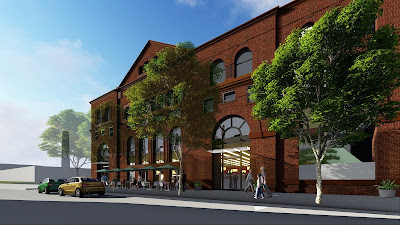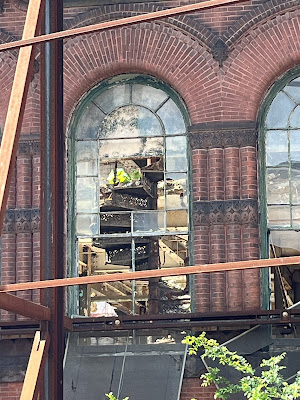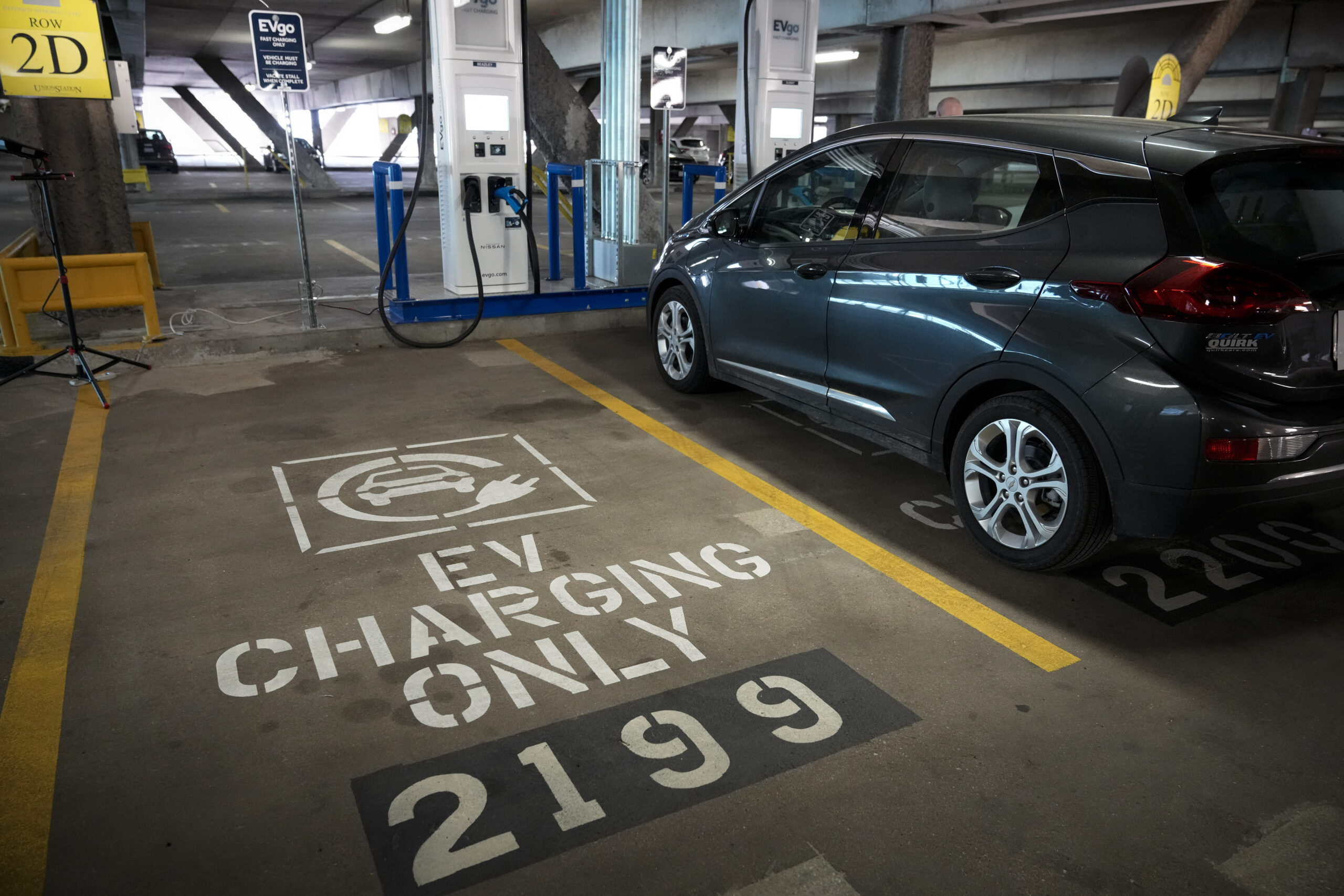Born in 1892 the stately building proudly stood for nearly a 100 years as an example of industrial Romanesque revival architecture that was easily able to accommodate as distinctly different uses as a power hub for cable cars, a theater and an ice-cream factory. Even after moving into public possession after some years of vacancy in the 1980s it still found good use as an employment facility of the City.
 |
| The Hendler Creamery structure around 2012 as shown on Commercial Construction website |
But then, in the 21st century, when the property was supposed to switch back into private hands via the Baltimore Development Corporation's "land disposition agreement" process, it joined the long list of projects that went off the rails and wound up eradicating history. In 2007 BDC selected preservation expert Marty Azola from two redevelopment proposals. The project to convert the facility into a private office building fell through in the recession, forcing Azola to sell the facility in foreclosure.
What followed in 2012 was the lofty vision of building an apartment building inside the voluminous structure. This vision was followed by the demolition of the eastern wall, roof, and interior, with the remaining walls shored up with the building's own bones, I.e. it’s steel beams. But that was the end of sctivity. Then the building fell into dormancy and the vision evaporated into nothing. The sad ransacked remainders of the once intact structure stood for six years left to the elements, fenced in and neglected.
 |
| Exterior shoring activity in 2018 as shown on Commerciial Construction website. |
As observers of Baltimore's development and preservation scene already know and the title line gives away, of course, we are talking about the Hendler Creamery, a facility that once covered a whole city Block between Fayette and Baltimore and East and Asquith Streets in the Jonestown historic district. The main structure was listed on the National Register as historically significant in 2007.
Jonestown historic district exemplifies the physical culture of a residential, commercial and industrial neighborhood that housed and employed several immigrant and class groups throughout the late 18th, 19th, and 20th centuries (CHAP staff report)
In June, CHAP sealed the fate of the Hendler Creamery by approving neglect and decay by declaring what is left of the building unsalvageable and ripe for demolition. The owner could have gotten off easier
 |
| Design Collective rendering of the originally envioned new project (Design Collective) |
The Hendler Creamery building was designed by local architect Jackson Gott in 1892 as a cable car powerhouse. The building powered the run of cable from Gay Street to North Avenue. In 1899, the United Railway and Electric Company, a Baltimore street car conglomerate, purchased the building and replaced the cable cars with electric streetcars. In 1903 prominent theater owner James L. Kernan converted the building to a theater. Kernan hired architect Edward Glidden to install a lobby, manager’s office, box office and an auditorium. A new floor was also inserted in the former engine room. In 1912, Lionel Manuel Hendler purchased the property and converted it into America’s first 1100 E. Baltimore – Hendler Creamery – Demolition Hearing One: Determination of Historic Significance (Jonestown Historic District) 2 completely automated ice cream plant. Between 1914 and 1915, Hendler added a third floor, and a bay to the eastern side of the structure (Image 6). The Hendler Company continued making ice cream until 1971 when Borden Company acquired the business. Ice cream was made at the site until the mid-1980s.(CHAP staff report)
This last vote was the end of a chain of a long slippery slope that began when the developer The
 |
| Current state of the building (Photo: Philipsen) |
Commercial Group,of Hanover, MD (website slogan: I am integrity - I am vision") bought the Hendler for $1.1. million. In 2014 the group proposed to CHAP a $45 million conversion of the 97,500-square-foot main Creamery building at 1100 E. Baltimore St.into 276 apartments and 11,000 square feet of retail space. Already in 2015 they came back to CHAP with additional demo in their baggage. It was granted and executed in 2018. Strange occurrences continued until this most recent hearing, including the loss of 1 hr of recording tape of the previous session on the same subject as well as the curious fact that the applicant for demolition wasn't the actual owner of the Hendler complex, Commercial Construction alias Hendler LLC but a non-profit that would buy the land, but only if the permission for demolition would be granted. And as it is frequently done, their application was based on CHAP's diffuse "economic hardship clause" in which an applicant has to show that preservation would not economically possible.
This application has highlighted anomalies in your current rules and procedures which deserve reform. For example- it is one thing for the owner of a designated structure to claim economic hardship, but it is nonsensical for a contract purchaser, someone who does not possess the property- whether that purchaser is HUM, or Mother Theresa, or Donald Trump- to declare economic hardship created by the owner in advance of ownership. Where is the current owner and what do you expect of them in effecting preservation? (Bill Pencek, former Deputy State Historic Preservation Officer in written testimony to CHAP)
Another strangeness of the CHAP demolition approval was that they blindly accepted the findings of an engineer that the Helping Hand non-profit has commissioned, ie. the very party that was very interested in demolition. The applicant himself had provided drone footage of the structure and selected the photos showing the deterioration that the engineering firm. CHAP did not entertain a second opinion of an engineering firm not in the service of the applicant. Century Engineering
 |
| The south facade still exhibits all the decor of the original facade from 1892 (Photo Philipsen) |
confirmed in their report. Helping Hand also provided the cost of stabilizing the walls in excess of the assessed value of the site, plus a half million dollars for engineering. There was no way to verify those estimates or the assertion that only "reconstruction" with all new materials would be a truly structurally viable solution.
We recommend that all three f a c a d e s be demolished as soon as possible. As discussed above, the degree and extent of deterioration eliminates the possibility of preserving the historic fabric.(Century Report).
Further irregularities appear to be that the Century finding deviates from the determination of Baltimore City inspectors who were dispatched to the site in September 2021 and then again this year to follow up on reports of unsafe site conditions and did not see any need for corrective action, let alone the danger of imminent collapse. The CHAP staff report of March doesn't mention the "hardship clause" and doesn't discuss its potential merits, since the hardship discussion occurred in an additional meeting in June, however without any additional engineering insights or without an amended staff report.
Any day a structure or building gets demolished that has been around for a century or so as part of the Baltimore urban landscape is a sad day. Many people don't agree. They are somehow glad to get rid of an old burden, delight in opening up a blank slate full of opportunity or simply happy to avoid the more complicated route. What proponents of liberal demolition overlook is the extent to which the history of a City shapes its people and its future. It is no coincidence that Baltimore's most successful neighborhoods are neighborhoods with a very high precentage of preservation such as Mount Vernon, Bolton Hill, Fells Point or Federal Hill. It is not by chance that Baltimore's successful projects are "adaptive ruse", i.e. new use in old shells, ranging from the Tindeco apartments, the American Can, to Tide Point, Clipper Mill, Silo Point, the Montgomery Ward and the Mills on Falls Road. As well as the old B&O headquarters on Charles Street. The list is long and Baltimore is with its creative preservation on par with its more famous brethren Washington DC, Philadelphia and Boston.
 |
| Current overall view (Baltimore SUN drone photo) |
For a city to succeed, preservation and new development need to form a delicate balance in which change and anonymity are not overwhelming its residents and preservation does not stifle development. But this is not happening here. The choice isn’t preservation or new development. It is some preservation or nothing. There is just no way that an open space on the site of the Creamery can replace the richness of the old building that could have been so many things before Commercial Construction purchased and destroyed it for its ambitious project that it never realized. The thing is that CHAP's regulations are explicit in prohibiting "demolition by neglect":
The Commission serves to promote the care and maintenance of designated historic structures in Baltimore City. As such, no property that has been designated by the Commission shall be allowed to deteriorate due to negligence, lack of maintenance or abandonment. The impact of such properties on the quality of life and character of the historic district is substantial. CHAP defines “Demolition by Neglect” as neglect in the maintenance or repair of a structure, resulting in any of the following conditions: (CHAP Regulations)
Ultimately CHAP’s decision was largely hinged on the hardship and imminent danger argument, both entirely based on facts and data presented by the applicant. Aside from their accuracy, whatever the true current conditions, they were entirely created by the owner of the site when he proceeded with demolition of the roof and parts of the interior in 2018 without
 |
| Originally suggested apartment building inside the Creamery facades (Design Collective) |
consideration how the remaining structures would hold up over time. The exposure of the interior and tops of the walls to the elements is what created today's conditions.
Klaus Philipsen, FAIA
PS: Even with the approval for full demolition Helping Hand should consider leaving at least a small portion of the south facade around the main entry standing as a reminder of what there once was. Thtat would not be historic preservation but a nod and gesture towards Baltimore's history. (7/11/23)
Timeline per CHAP staff report:
o September 11, 2012 - CHAP determined that adjacent structures 1101-1105 E. Fayette Street, 1107 E. Fayette Street and 1110 E. Baltimore Street did not contribute to the Jonestown Local Historic District.
o November 12, 2013 - CHAP approved demolition for the structures determined noncontributing (1101-1105 E. Fayette Street, 1107 E. Fayette Street and 1110 E. Baltimore Street).
o December 10, 2013 - CHAP gave concept approval of the proposed new construction in height, massing, and scale. The Hendler development team presented a plan to construct a new six-story structure with 254 apartment units and two floors of underground parking, and to rehabilitate the Hendler Creamery building. In addition, CHAP gave concept approval of the Hendler building plans with the following amendments:
▪ Preserve the “Laboratories” sign and second story window frames.
▪ Redesign the proposed complete removal of gabled roof area. (The staff report stated: “The removal of the gable roof as proposed changes the overall volume and shape of the structure, which will detract from the historic character of the structure.”) Next Steps:
▪ The applicant will need to address all issues regarding changes to the eastern property line on Aisquith Street and other development procedure requirements prior to returning to CHAP. ▪ Landscape details will come back to the full commission.
▪ The applicant will need to present final details (building features, materials and detailing) of the new construction to the full commission.
▪ The applicant will need to present to the full commission the Hendler Creamery restoration plans for repointing, window details, masonry repair, and roof design. 1100 E. Baltimore – Hendler Creamery – Demolition Hearing One: Determination of Historic Significance (Jonestown Historic District) 3
o August 11, 2015 – CHAP approved concept plans with final details to come to the full Commission for review. At the Commission hearing, the new development team presented its request to alter the previously approved 2013 plans. The new plan proposed the demolition of the Hendler building’s entire east elevation, one bay of the tripartite north elevation, and the building’s interior structure. A new east elevation wall would be constructed of contemporary materials that would support a replication of the existing gable roof running the length of the building. CHAP staff presented a finding of disapproval to the Commission due to the extent of the proposed demolition and the fact that the project had received conceptual approval in 2013 with the understanding that the historic building would be rehabilitated. Contrary to the staff recommendation, the Commission issued concept approval of the developer’s proposal, with final details to come to the full Commission for review.
o April 11, 2017 – CHAP approved amendments to the previously approved plans affecting the building with final details to be reviewed by staff.
o August 15, 2018 -DHCD APPROVED demolition permit to remove the following:
• On the North elevation, remove the three-story easternmost (later) section of façade
• Raze entire east elevation • Remove roof sheathing and roofing panels, remove roof trusses when shoring is complete
• Remove all interior elements • Shore north, south and west elevations in accordance with shoring plan.
o September 20, 2021 – DHCD building inspector investigated the building due to a complaint of possible dangerous conditions that could result in imminent safety conditions. The inspector determined that there was no cause for any action at this time. Fencing enclosed entire structure, and the structural steel supports entire front and west side of building.
o February 9, 2023 - DHCD Assistant Commissioner evaluated the structural engineer’s report and concurred with the findings.

